1. Component views
Engine mounting

Part name
- Bolt
- Right side engine foot
- Bolt
- Bolt
- Right side engine mounting
- Bolt
- Left side engine foot
- Bolt
- Bolt
- Left side engine mounting
Tightening torque
1: 131 N・m { 13.4 kgf・m / 97 lb・ft }
3: 51 N・m { 5.2 kgf・m / 38 lb・ft }
4: 116 N・m { 11.8 kgf・m / 86 lb・ft }
6: 131 N・m { 13.4 kgf・m / 97 lb・ft }
8: 51 N・m { 5.2 kgf・m / 38 lb・ft }
9: 116 N・m { 11.8 kgf・m / 86 lb・ft }
2. Engine mounting installation
1) Install the left and right engine feet to the engine.
Tightening torque: 51 N・m { 5 kgf・m / 38 lb・ft }
2) Hold up the engine as high as not to be lifted up.
3) Install the right side engine mounting to the frame.
Caution
- Perform the work to prevent damage to the engine or vehicle side parts.
- If the left side engine mounting is installed first, the right side engine mounting cannot be installed.
- Check the marking on the engine mounting.
| Marking |
Transmission |
Left/Right |
| JL |
MT |
Left |
| JR |
MT |
Right |
| JAL |
AT |
Left |
| JAR |
AT |
Right |
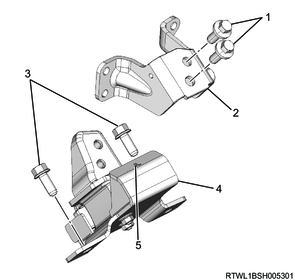
Legend
- Engine foot side bolt
- Engine foot
- Engine mounting side bolt
- Engine mounting
- Mark
4) Move the engine to a position where the left side engine mounting can be installed.
5) Install the left side engine mounting to the frame.
6) Lower the engine.
7) Install the right and left engine feet to the engine mounting.
Tightening torque: 131 N・m { 13.4 kgf・m / 97 lb・ft }
Engine left side
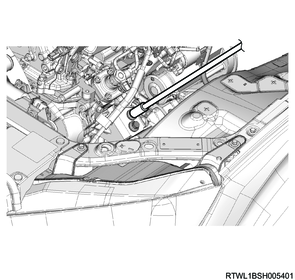
Engine right side
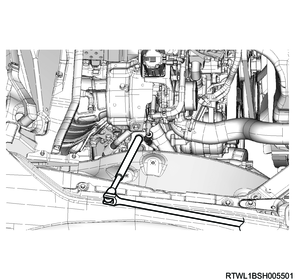
8) Remove special tool from the cylinder head.
9) Connect the engine mounting to the frame.
Caution
- Always tighten bolts while the engine is securely seated on the frame.
- Tightening bolts while the engine mounting has risen up off the frame may cause bolts to be loosened.
Tightening torque: 116 N・m { 11.8 kgf・m / 86 lb・ft }
3. Starter motor installation
1) Install the starter motor to the rear plate.
Tightening torque: 97 N・m { 9.9 kgf・m / 72 lb・ft }
2) Connect the earth cable to the starter motor.
4. Front propeller shaft installation
1. 4WD models
Refer to "3.Driveline, Axle 3C.Drive Shaft System front propeller shaft installation".
5. Oil level gauge guide tube installation
1) Apply engine oil to the O-ring.
Caution
- Do not reuse the O-ring.
2) Install the oil level gauge guide tube to the crankcase.
Tightening torque: 25 N・m { 2.5 kgf・m / 18 lb・ft }
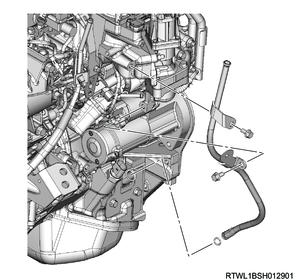
3) Install the oil level gauge to the oil level gauge guide tube.
6. Oil filter installation
1) Temporarily tighten the oil filter and gasket to the oil cooler in the order shown in the diagram.
Caution
- Do not reuse the gasket.
- Ensure that no dirt or foreign material enters.
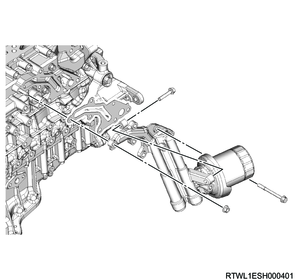
2) Final tighten the oil filter to the oil cooler in the order shown in the diagram.
Tightening torque: 25 N・m { 2.5 kgf・m / 18 lb・ft }
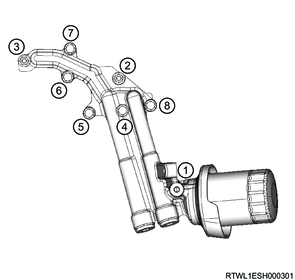
7. EGR water pipe installation
1) Install the EGR water pipe to the oil cooler and turbocharger lower bracket.
Tightening torque: 25 N・m { 2.5 kgf・m / 18 lb・ft }
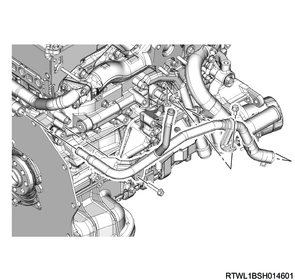
2) Connect the water hose to the water intake pipe and return hose.
8. Water intake pipe installation
1) Temporarily tighten the water intake pipe and water hose to the oil cooler in the order shown in the diagram.
Caution
- Do not reuse the gasket.
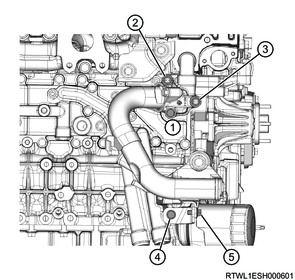
2) Final tighten the water intake pipe and water hose to the oil cooler in the order shown in the diagram.
Tightening torque: 25 N・m { 2.5 kgf・m / 18 lb・ft }

9. Radiator lower hose connect
1) Connect the radiator lower hose and clamp to the water intake pipe.
Note
- Insert the lower hose until it makes full contact with the pipe.
- Soapy water can be applied when installing the lower hose.
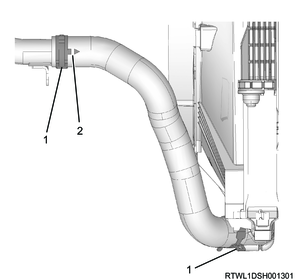
Legend
- Clamp
- Arrow mark
Note
- Align the clamp with the lower hose arrow mark end to install.
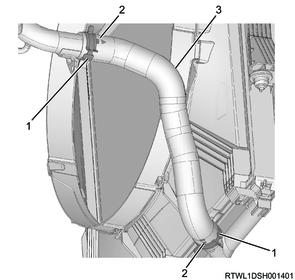
Legend
- Clamp
- Arrow mark
- Radiator lower hose
Note
- Install the clamp in the direction shown in the following diagram.
- The diagram about the clamp direction shows the state viewed from the vehicle front.
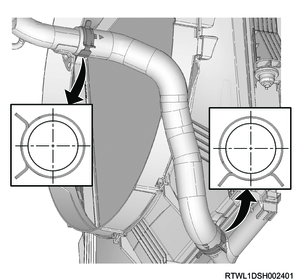
10. EGR cooler installation
1) Temporarily tighten the EGR duct and gasket to the EGR cooler in the order shown in the diagram.
Caution
- Do not reuse the gasket.
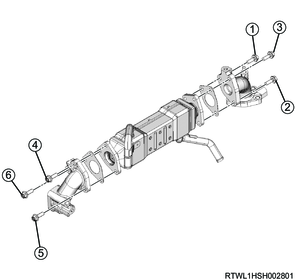
2) Final tighten the EGR duct to the EGR cooler in the order shown in the diagram.
Tightening torque: 27 N・m { 2.8 kgf・m / 20 lb・ft }

3) Install the EGR duct gasket to the cylinder head.
Caution
- Do not reuse the gasket.
Note
- Face the protruding section of the gasket toward the upper side of the engine.

Legend
- Protrusion
4) Temporarily tighten the EGR cooler and gasket to the cylinder head and exhaust manifold in the order shown in the diagram.
Caution
- Do not reuse the gasket.
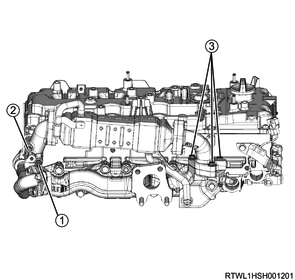
5) Final tighten the EGR cooler to the cylinder head and exhaust manifold in the order shown in the diagram.
Tightening torque: 27 N・m { 2.8 kgf・m / 20 lb・ft }

6) Install the harness bracket to the EGR duct.
Tightening torque: 25 N・m { 2.5 kgf・m / 18 lb・ft }
7) In the order shown in the diagram, temporarily tighten the heat protector to the EGR duct.
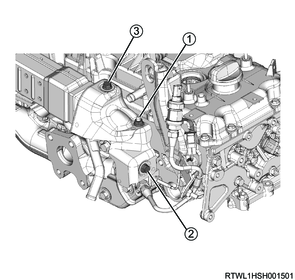
8) In the order shown in the diagram, final tighten the heat protector to the EGR duct.
Tightening torque: 25 N・m { 2.5 kgf・m / 18 lb・ft }

11. EGR cooler water hose connect
1) Connect the EGR cooler water return hose to the EGR cooler.
2) Connect the EGR cooler water feed hose to the EGR cooler.

Legend
- EGR cooler water return hose
- EGR cooler water feed hose
12. Turbocharger installation
1) Install the following parts as a set to the exhaust manifold.
- Turbocharger
- Turbocharger oil pipe
- Water feed and return pipe
Caution
- Do not reuse the gasket.
Tightening torque: 52 N・m { 5.3 kgf・m / 38 lb・ft }
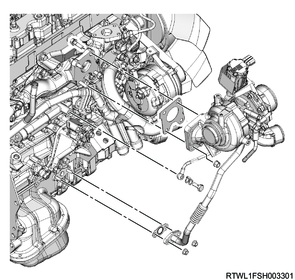
2) Connect the connector to the turbocharger.
13. Turbocharger oil pipe connect
1) Connect the turbocharger oil pipe to the oil cooler and crankcase.
Caution
- Do not reuse the gasket.
Tightening torque: 25 N・m { 2.5 kgf・m / 18 lb・ft } Crankcase side
Tightening torque: 23 N・m { 2.3 kgf・m / 17 lb・ft } Oil cooler side
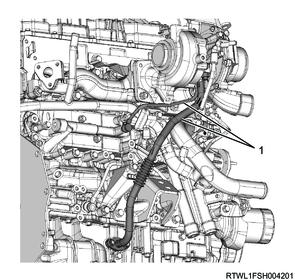
Legend
- Turbocharger oil pipe
14. Turbocharger water hose connect
1) Connect the turbocharger water return hose to the water feed and return pipe.
2) Connect the turbocharger water feed hose to the water feed and return pipe.

Legend
- Turbocharger water feed hose
- Turbocharger water return hose
15. DPD installation
1) Temporarily tighten the DPD and exhaust pipe bracket to the crankcase in the order shown in the diagram.
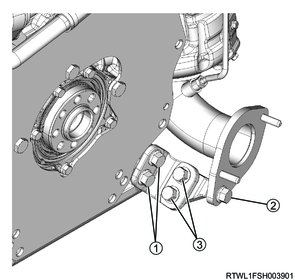
2) Temporarily tighten the DPD bracket to the following parts in the order shown in the diagram.
- DPD
- Oil cooler side bracket
- Turbocharger lower bracket
- Turbocharger upper bracket
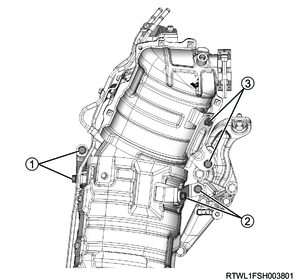
3) Temporarily tighten the DPD to the turbocharger using a V-band.
Caution
- Do not reuse the gasket.
- Assemble with the gasket yellow paint section facing toward the DPD.
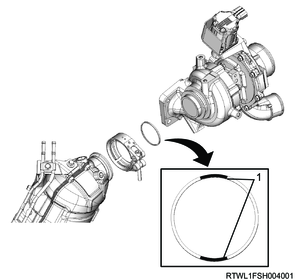
Legend
- Yellow paint section
V-band assembly direction
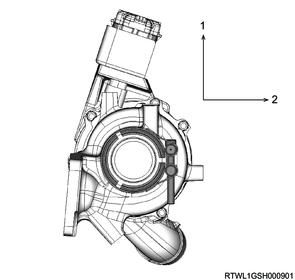
Legend
- Top
- RH
4) Final tighten the DPD and exhaust pipe bracket to the crankcase in the order shown in the diagram.
Tightening torque: 94 N・m { 9.6 kgf・m / 69 lb・ft }

5) Final tighten the DPD bracket to the following parts in the order shown in the diagram.
- DPD
- Oil cooler side bracket
- Turbocharger lower bracket
- Turbocharger upper bracket
Tightening torque: 25 N・m { 2.5 kgf・m / 18 lb・ft }

6) Align the markings, and then connect the differential pressure hoses to the DPD.
Caution
- Install the differential pressure hose clip securely so that there is no gas leakage.
- Do not use cracked hoses.
- If there is gas leakage from connections, the sensor may malfunction.
- After starting the engine, verify that there is no gas leakage.

Legend
- White paint
- Green paint
7) Final tighten the V-band to the DPD and turbocharger.
Note
- Turn the V-band bolt, pushing it into the joint pin.
Caution
- Tighten in 2 stages.
Tightening torque: 12 N・m { 1.2 kgf・m / 106 lb・in }
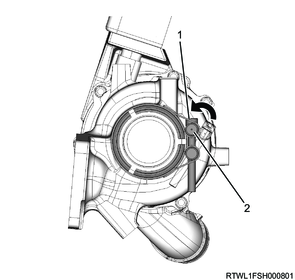
Legend
- V-band bolt
- Joint pin
8) Install the heat protector to the turbocharger.
Tightening torque: 25 N・m { 2.5 kgf・m / 18 lb・ft }

Legend
- Heat protector
16. Steering shaft connect
1) Install the lower second steering shaft to the second steering shaft according to the alignment marks placed during removal.
Caution
- Install while it makes contact with the yoke.
- Tighten the bolt by hand until seated and final tighten.
- Tighten the tire while it is in contact with the ground.
Tightening torque: 31 N・m { 3.2 kgf・m / 23 lb・ft }
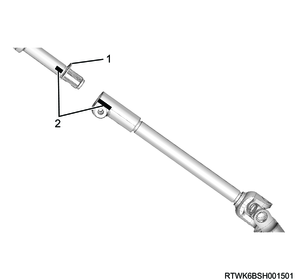
Legend
- Yoke
- Alignment mark
2) Connect the universal joint to the power steering unit according to the alignment marks placed during removal.
Tightening torque: 31 N・m { 3.2 kgf・m / 23 lb・ft }
17. Exhaust pipe installation
18. Generator installation
1) Install the generator to the lower bracket.
Tightening torque: 40 N・m { 4.1 kgf・m / 30 lb・ft }

2) Install the upper bracket to the generator and timing gear case.
Tightening torque: 25 N・m { 2.5 kgf・m / 18 lb・ft }
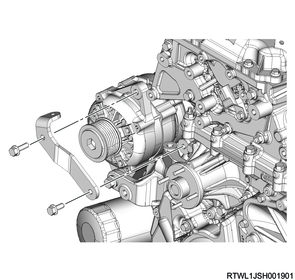
3) Connect the connector to the generator.
4) Connect the B-terminal to the generator.
Tightening torque: 12 N・m { 1.2 kgf・m / 106 lb・in }
19. Cooling fan belt installation
1) Install the cooling fan belt to the following parts.
- Fan pulley
- Generator
- Crankshaft pulley
MT models

Legend
- Adjust bolt
- Cooling fan belt
- Lock nut
AT models
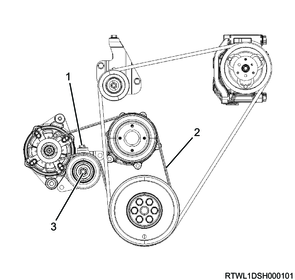
Legend
- Adjust bolt
- Cooling fan belt
- Lock nut
20. Cooling fan belt adjustment
When installing a new belt, initial stretching of the belt occurs.
In addition, when reusing the belt, the belt needs to be fitted to the pulley groove.
After fitting the cooling fan belt, readjust the cooling fan belt tension.
1) Loosen the tension pulley lock nut using a wrench.
2) Adjust the cooling fan belt tension by turning the adjust bolt.
Note
- The standard amount of deflection shown is the value obtained when the standard pressure is applied to the midpoint of the fan pulley and generator.
Standard: 98 N { 10.0 kg / 22 lb }
Caution
- Accurately adjust the tension as there is a possibility the service life of the belt may be shortened or belt squeal may be generated if the tension is not within the appropriate range.
- Use a sonic tension meter to verify accurate tension adjustment.
| Adjustment conditions |
Deflection |
Vibration frequency |
| When new |
5.0 to 6.0 mm { 0.20 to 0.24 in } |
207 to 231 Hz |
| Reused |
7.0 to 7.8 mm { 0.28 to 0.31 in } |
176 to 190 Hz |
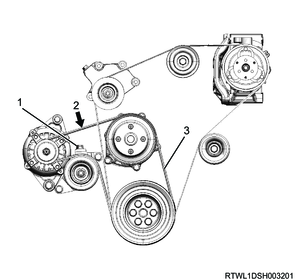
Legend
- Tension pulley adjust bolt
- Measurement point
- Cooling fan belt
3) Tighten the tension pulley lock nut to the specified torque.
Tightening torque: 41 N・m { 4.2 kgf・m / 30 lb・ft }
21. A/C compressor drive belt installation
1. M/T models (Euro 5 or above)
1) Install the A/C compressor drive belt to the following parts.
- Tension pulley
- A/C compressor
- Crankshaft pulley
- Idle pulley
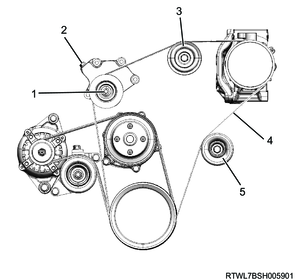
Legend
- Lock nut
- Adjust bolt
- Idle pulley
- A/C compressor drive belt
- Idle pulley
2. Except M/T models (Euro 5 or above)
1) Install the A/C compressor drive belt to the following parts.
- Tension pulley
- A/C compressor
- Crankshaft pulley
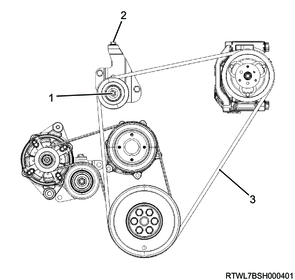
Legend
- Lock nut
- Adjust bolt
- A/C compressor drive belt
22. A/C compressor drive belt adjustment
1. M/T models (Euro 5 or above)
When installing a new belt, initial stretching of the belt occurs.
In addition, when reusing the belt, the belt needs to be fitted to the pulley groove.
After fitting the A/C compressor drive belt, adjust the tension of the A/C compressor drive belt again.
1) Loosen the tension pulley lock nut.
2) Turn the tension pulley adjust bolt to adjust the tension.
Note
- The standard deflection shown is the value obtained when the specified load is applied to the measurement point of the A/C compressor drive belt.
98 N { 10.0 kg / 22 lb } Load
Caution
- Accurately adjust the tension as there is a possibility the service life of the belt may be shortened or belt squeal may be generated if the tension is not within the appropriate range.
- Use a sonic tension meter to verify accurate tension adjustment.
| Adjustment conditions |
Deflection |
Vibration frequency |
| When new |
10.2 to 11.2 mm { 0.40 to 0.44 in } |
163 to 179 Hz |
| Reused |
12.1 to 13.3 mm { 0.48 to 0.52 in } |
131 to 147 Hz |
| Adjustment conditions |
Deflection |
Vibration frequency |
| When new |
6.8 to 7.4 mm { 0.27 to 0.29 in } |
249 to 273 Hz |
| Reused |
7.9 to 8.7 mm { 0.31 to 0.34 in } |
201 to 225 Hz |
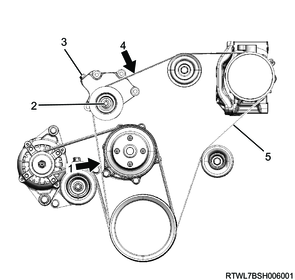
Legend
- Measurement point 1
- Lock nut
- Adjust bolt
- Measurement point 4
- A/C compressor drive belt
3) Tighten the tension pulley lock nut to the specified torque.
Tightening torque: 51 N・m { 5.2 kgf・m / 38 lb・ft }
2. Except M/T models (Euro 5 or above)
When installing a new belt, initial stretching of the belt occurs.
In addition, when reusing the belt, the belt needs to be fitted to the pulley groove.
After fitting the A/C compressor drive belt, adjust the tension of the A/C compressor drive belt again.
1) Loosen the tension pulley lock nut.
2) Turn the tension pulley adjust bolt to adjust the tension.
Note
- The standard deflection shown is the value obtained when the specified load is applied to the measurement point of the A/C compressor drive belt.
98 N { 10.0 kg / 22 lb } Load
Caution
- Accurately adjust the tension as there is a possibility the service life of the belt may be shortened or belt squeal may be generated if the tension is not within the appropriate range.
- Use a sonic tension meter to verify accurate tension adjustment.
| Adjustment conditions |
Deflection |
Vibration frequency |
| When new |
12.5 to 16.5 mm { 0.49 to 0.65 in } |
92 to 112 Hz |
| Reused |
16.5 to 19.1 mm { 0.65 to 0.75 in } |
79 to 91 Hz |
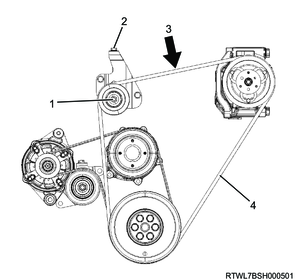
Legend
- Lock nut
- Adjust bolt
- Measurement point
- A/C compressor drive belt
3) Tighten the tension pulley lock nut to the specified torque.
Tightening torque: 51 N・m { 5.2 kgf・m / 38 lb・ft }
23. Air cleaner installation
1) Install the air cleaner to the vehicle.
Tightening torque: 20 N・m { 2.0 kgf・m / 15 lb・ft }
2) Connect the connector to the MAF and IAT sensor.
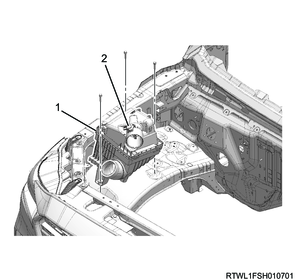
Legend
- Air cleaner
- MAF and IAT sensor
24. Air duct installation
1) Align the air duct with the air cleaner and turbocharger.
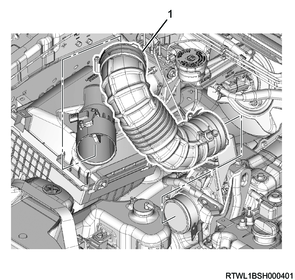
Legend
- Air duct
2) Referring to the diagram, align the alignment mark positions and connect the air duct to the turbocharger.
Tightening torque: 4.0 N・m { 0.4 kgf・m / 35 lb・in }
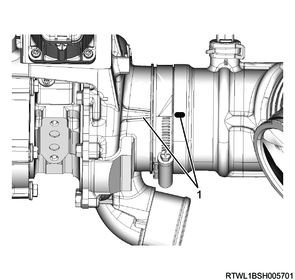
Legend
- Alignment mark
3) Install the PCV hose to the cylinder head cover and air duct.
Caution
- Align the marks on the pipe side and hose side.
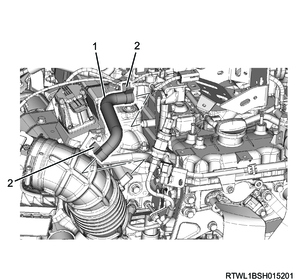
Legend
- PCV hose
- Clamp
4) Install the intake air duct to the air cleaner and radiator core support.
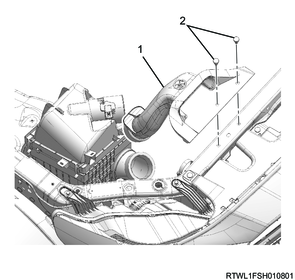
Legend
- Intake air duct
- Clip
25. Engine cover installation
1) Install the engine cover to the engine.

Legend
- Engine cover
26. Cowl panel installation
1) Install the cowl panel to vehicle.

27. Wiper linkage installation
28. Engine hood installation
29. Coolant filling
1) Fill with engine coolant up to the radiator filler neck.
Note
- Fill with engine coolant of the specified concentration to the brim of the radiator cap inlet.
Caution
- Fill slowly to prevent air from entering the system.
2) While pressing the radiator upper hose manually several times to bleed the air from the hose, fill the radiator with engine coolant.
Note
- Fill with engine coolant up to the brim of the radiator cap inlet with the amount the engine coolant lowers.
Caution
- Repeat the operation until the coolant level no longer drops.
3) Add engine coolant up to the MAX line of the radiator reserve tank.
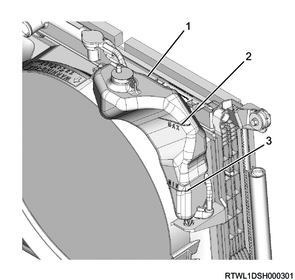
Legend
- Radiator reserve tank
- MAX line
- MIN line
4) Install the radiator cap to the radiator.
5) Start and idle the engine.
Caution
- Idle the engine for 5 minutes or more.
6) Stop the engine.
7) Remove the radiator cap from the radiator.
Warning
- Do not loosen the radiator cap or reserve tank cap when coolant is hot, as doing so may result in burns caused by the release of steam or hot water.
- When opening the radiator cap, cover the cap with a thick cloth once the engine coolant has cooled and slowly turn to release pressure.
8) Fill with engine coolant up to the radiator filler neck.
Note
- If the engine coolant is excessively low, inspect for engine coolant leakage from the cooling system.
9) Install the radiator cap to the radiator.
10) Start the engine.
11) Increase the engine speed to around 2000 rpm and run the engine for 10 minutes once the engine coolant temperature gauge reaches the center.
12) With the engine running, check that the thermostat valve is open.
Note
- Touch the radiator upper hose, and confirm that it has become warm.
- If it has not become warm, go back to Step 11.
Caution
- Do not try determining it by using only an engine coolant temperature gauge.
13) Idle the engine for 5 minutes.
14) Stop the engine.
15) Remove the radiator cap from the radiator.
Warning
- Do not loosen the radiator cap or reserve tank cap when coolant is hot, as doing so may result in burns caused by the release of steam or hot water.
- When opening the radiator cap, cover the cap with a thick cloth once the engine coolant has cooled and slowly turn to release pressure.
16) Fill with engine coolant up to the radiator filler neck.
Note
- Fill with engine coolant of the specified concentration to the brim of the radiator cap inlet.
17) Add engine coolant up to the MAX line of the radiator reserve tank.
18) Install the radiator cap to the radiator.
19) Repeat steps 10 to 18 until the coolant level no longer lowers.
Caution
- If the level of the radiator reserve tank has fallen the next morning, add up to the MAX line.
30. Engine oil filling
1) Replenish the engine with the engine oil.
2) Check the tightening of the oil pan drain plug.
Tightening torque: 44 N・m { 4.5 kgf・m / 32 lb・ft }
31. Underguard installation
32. Preliminary and post procedures
1. Post procedures
1) Lower the vehicle.
2) Connect the battery cable to the battery negative terminal.
3) Referring to the following, perform the setting of the front door power window switch with AUTO UP/AUTO DOWN function.
Refer to "9.Body, Cab, Accessories 9T.Glass, Windows, Mirrors front door power window switch setting".
4) Close the engine hood.